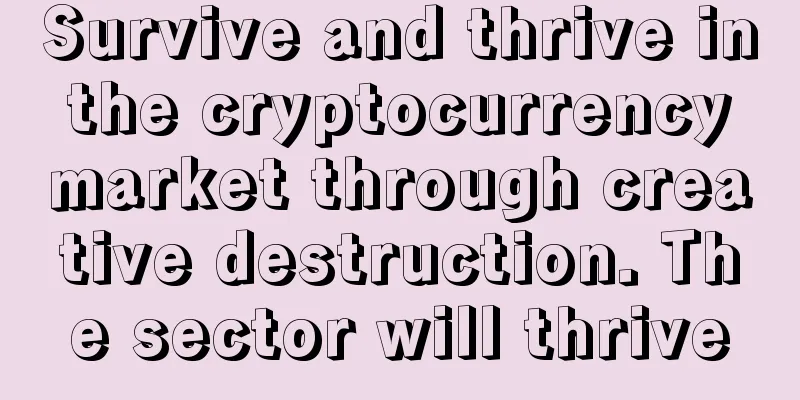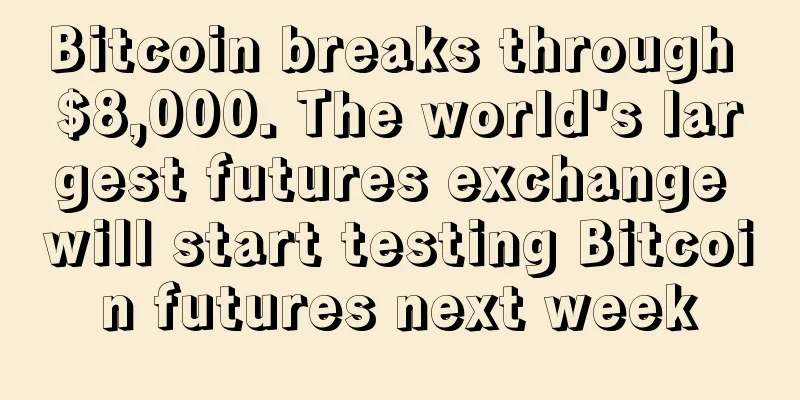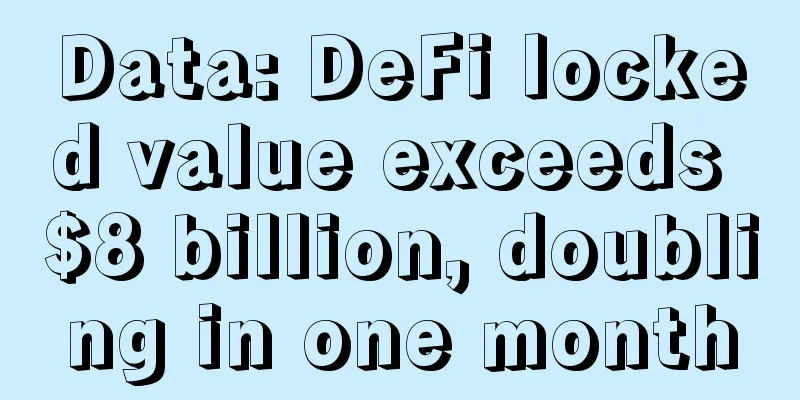Survive and thrive in the cryptocurrency market through creative destruction. The sector will thrive

|
As investors who came up through the ranks in the emerging market equity space, we have looked at cryptocurrencies with great excitement over the past few years. We are very aware of the difference between market prices and actual conditions. The key to successful investing is to understand this difference. As historical stock investors, we have always used a phrase in our business: we invest in stocks, not companies. In this post, we take a deep dive into how this can be applied to the massive opportunity that is cryptocurrency. The parallels to investing in old emerging markets are clear: the potential is everywhere, and each founder can tell a great story about how their particular project will change the world — made possible by the broader narrative of potential growth. In stocks and crypto alike, discerning the difference between potential winners and potential losers (and there will be many) is a challenge in the best of times due to information asymmetries between founders, investors, and the broader community. But in crypto, this challenge is compounded by the fact that we are still early in crypto’s life cycle: some of tomorrow’s winners may not yet have been invented, let alone thought of; and today’s winners may well fade into obscurity in the coming years. That said, our message is one of encouragement and motivation, especially as we find ourselves in range-bound, choppy waters. On the one hand, there have been tremendous advances in what crypto can do, especially in the DeFi space, and we cannot let volatility and market dislocation distract us from that fact. On the other hand, there are also a lot of worthless pieces that are scooped up by the rising tide, taking advantage of the hype cycle, and as the tide recedes, these pieces are likely to return to zero. Maintaining a healthy skepticism of existing views and admitting that we may be wrong allows us to re-examine our beliefs and evolve with the market. If we still believe that our views are correct after careful scrutiny and public criticism, then it is more convincing. Just as not every “emerging market” upstart ends up being a runaway success, it’s also true that in crypto, no amount of big-picture potential can erase the challenges. No matter how strong your background, surviving in the market is not a right - just ask the legions of dot-com boom investors who never saw their money again. Avoiding losses is just as important as capturing gains, if not more so. The "numba go up" pure bull run may not last, but the good news is that there is still multifaceted reward potential for those who put in the work. Cryptocurrency offers a generational opportunity to those who make the effort to learn, examine, and take reasonable risks to gain exponential wealth. It is more open and accessible than any traditional equity investment, with founders engaging directly with their community and on-chain metric transparency as the standard. No investment bank will place restrictions on information access, because these barriers do not exist in the on-chain world, and you, in crypto, are far ahead of the average large institutional investor. The agency will have to buy it from you – let that thought sink in for now. So let’s keep our eyes on the prize and get to work. The fundamentals haven’t changedThe birth of decentralized finance (DeFi) and its potential to improve (or in some cases replace) traditional banking services offered around the world, in both developed and developing economies, is profound. Out of pure curiosity, we attended the first DeFi conference at Imperial College London in 2019. We realised we had stumbled onto something special. “Crazy” was an understatement, although even at the time it wasn’t clear how anyone could make money from anything. But one thing struck us: the sheer number of bright young people investing their time and resources into developing a permissionless banking system based entirely on code, free from the interference of third-party middlemen, was an almost statistically guaranteed result of producing some brilliant, creative people. What was fascinating was that the mentality was one of mutual cooperation, not competition as we see elsewhere. Two years on, price volatility aside, the crypto community — and projects in DeFi in particular — have a lot to be proud of. From decentralized lending to yield aggregators to automated market makers, the level of innovation is astounding. Cryptocurrency, on the other hand, is highly public. It’s a market with no barriers to entry. The wave of liquidity flowing into the system, coupled with the hype machine of Twitter, memes, YouTube, TikTok, and everything else, has turned the market into the Wild West: no guarantees, no regulation, and all-around freedom. It is ripe for anyone with the ability to manipulate it. No wonder when numba goes up, it really goes up; when numba goes down… Insight 1: Some things will return to zeroFirst, the bad news. There will be a lot of zeros. As we’ve written before on our blog, decentralization is coming. While a handful of brilliant, innovative DeFi protocols have grown their businesses over the past few years — AAVE, Maker, Uniswap, Curve, Yearn, and Synthetix, to name a few — there are many others that may be doomed to fail and become obsolete. There’s nothing wrong with that — this is exactly how it’s supposed to work, a brutal process of creative destruction where only the best projects survive. That’s DeFi Darwinism. Lots of experiments, some of which succeed, and most of which don’t, and none of which have the right to survive. Think of the first generation of Layer 1 chains, which have been promising (and continue to only promise, not deliver), and the tokens that were a bit over the top in terms of joking — we won’t name names, but we all know exactly what we’re thinking. The classic imagery of dispersion is "separating the wheat from the chaff." Ideally, this would be the most comfortable solution on the market, as bad projects would simply be thrown away, while good ones would remain. Unfortunately, this is not the case. Whether it is a function of narrative, market structure, participant composition, or any combination of the three, correlation is high at this early stage in crypto. The common narrative of “Bitcoin is the largest cryptocurrency and everything else is equal but different” has led to the fate of the entire market being dependent on the sentiment surrounding Bitcoin. This is starting to change, but only slightly. Every bear market cycle goes through a cleanup, and the next bull market tends to see new ideas and projects gain real traction, distinguishing them from the already established ones. Separating the good from the bad in cryptocurrency is more akin to refining gold in fire. Everything melts but the impurities are incinerated, leaving the good stuff behind. The test of fire is not pleasant, but it is the only way to unravel an instrument so inextricably intertwined. Many tokens represent little more than ideas, as do some stocks. Regardless of the asset type, reality will always catch up: if it’s worth zero, it’s going to go to zero one way or another. This is especially true if the only reason something is valuable is because of price appreciation. Sound familiar? Not surprisingly, cryptocurrencies have gained a bad reputation as “casinos.” We all have a role to play in breaking free of this image. As we mentioned before, for better or worse (and we think for better), most projects are publicly traded 24/7, and sometimes we can lose sight of the fact that the fundamental progress of a project is tied to its publicly traded price. Just like stocks, but more so. Since cryptocurrencies largely lack institutional participation, the stickiness of the currency is low — generally speaking. What about “HODLers,” you might ask? The fact that people have to be told to HODL itself means that the decision to hold is not self-evident. “The fact that reminders are needed shows that, contrary to what the meme would represent, capital is not sticky. Why? Because in the back of their minds there’s a niggling doubt that says, “What if this is all a Ponzi scheme with zero value?” This doubt fades during a bull market but returns with a vengeance once the “upside only” is over, and the reason it exists is because with all the shillings and promises of quick money going on – no one is really sure if they’re being sold a dud. Of course, there are maximalists who become ideologically invested in their favorite projects and are determined to never sell — and sometimes it pays off (like Bitcoin or Ethereum), and sometimes it doesn’t (like Bitconnect). Who knows if they actually have diamond hands? Survivorship bias is huge — remember, almost no one tells people about the coins they HODL at zero. Insight 2: Lemon Theory and Market InstitutionsOne of our favorite economic theories is what is colloquially known as the “Lemon Theory.” The long form of the paper title is “The Market for Lemons: Quality Uncertainty and Market Mechanisms,” and the author is George Akerlof, winner of the 2001 Nobel Prize in Economics (shared with Michael Spence and Joseph Stiglitz). What is less known is that his wife is Janet Yellen, former Federal Reserve Chairman and current Treasury Secretary. The lemon theory tells a story of information asymmetry: A buyer goes to a used car market where there are two types of used cars. Both good used cars (peaches) and bad used cars (lemons) are on sale, but the buyer cannot judge the nature of the car by appearance alone. He relies on a used car salesman to promote the cars on offer. However, while the ignorant buyer wants to look for a good car (peach), the used car salesman wants to sell the bad car (lemon) at the price of a good car. Does this sound familiar? Most importantly, the buyer knows that the salesman is motivated this way. So, what happens? In short, the buyer needs a car but is unsure if the salesman is selling junk. So, he must assume that all cars are lemons and bid accordingly. This is bad news for Peaches, but now everything is a lemon because of the salesman's selfish motivations. The same is true of the cryptocurrency market. There are a lot of lemons and few peaches, but because there are too many used car salespeople around, anyone who does not have access to this asymmetric information and cannot distinguish between lemons and peaches, and who gets involved in the stock market because the market "only goes up and never goes down", will act first and ask questions later. Lemons are like peaches. It’s programmed, and that’s what we’ve got now. Whenever we look at a market, the most important thing for us is to understand the market structure. Once you understand who your adversaries are, you can build a mental model of how these different actors tend to behave in different situations. Obviously, investors in meme tokens are different from investors in DeFi, and investors in Bitcoin today have a completely different profile than Bitcoin investors a year ago, let alone a year ago. Furthermore, different investor types have different levels of knowledge, understanding, and belief. It is absolutely essential to understand this – if you know, you know. Traffic drives markets in the short and long term. Anyone who believes in the structural bull case for crypto wants to put long-term, sticky money into projects that are fundamentally guaranteed to be funded. Over time, this dampens volatility and increases the incentive for projects to do things right. Create something useful instead of chasing the bull market to sell you something like Shiba Inu Coin. DeFi has attracted worldwide attentionThe good news is that there is a ton of useful experimentation going on in crypto. Unlike 2017-18, when much of the space was “evaporator” with no material other than white papers and clever ideas, we are now finding projects that have not only successfully deployed but have also achieved product-market fit and have gone on to become profitable on their own. Rapidly rising prices have captured the attention of everyone from gun traders to institutional investors. The latter were arguably slow to join, but they will enjoy the benefit of hindsight. Nothing separates the good from the bad like a bear market. Exchanges that don’t require market makers, banks that don’t require bankers or loan officers, ecosystems that allow protocols to interact freely and seamlessly – these are investment opportunities that all investors have dreamed of for decades. Trust us when we say that checking the quarterly results of any commercial/investment bank, brokerage, or exchange operator anywhere in the world is one of the least appealing things to find on a to-do list. They’re here for these opportunities. When we start seeing traditional investment funds writing research reports on Ethereum and DeFi projects like we did recently, you know things are getting serious. Yes, they may be more cautious in their investment approach and steer clear of the heady (at least on the way up) YOLO approach that many of us took at some point in our crypto journey. But they will provide steady funding to projects that show the most basic promise. They are doing the work and when they come they will only buy the best. We need to get in first. This recent sell-off is our chance to shift our focus away from ideologies like “only up” and “moonshots!” and properly understand how projects create tangible value (or not). Think of the projects that have proven themselves to be key pieces of DeFi infrastructure during this cycle: Ether, Aave, Synthetix, YFI, Curve, Compound, Maker, Uniswap — the list goes on. Some were small before the DeFi summer, but there’s a good chance they’ll be bigger and stronger next time around, and it’s almost certain that the second wave of new projects may still be budding and developing at this point. In the broader crypto space, the same principle applies: the projects that ultimately survive and thrive are those with appropriate intrinsic value. We’ve already seen some very innovative applications of token economics and building this loop: from blockchain games in the metaverse to companies like Axie Infinity whose metrics are lighting up; bootstrapping global wireless networks like Helium has done with a steady increase in hotspot numbers and utilization; NFT art auctions seeing huge success at the most prestigious auction houses putting a new generation of artists in the global spotlight. There will be more. Creators, musicians, and others are just beginning to figure out how blockchain technology can advance their industries. For us, unbanking is more than just being able to replicate basic banking functions. It’s about generating an entire ecosystem that absorbs tangible, real-world value, allowing for seamless transfer of value within and outside of the ecosystem. If your bank holds the keys to your fiat currency (or all other real-world assets), you can’t break away from them. There is still a lot of work to be done and this is by no means the end. This is just the beginning. Don't ask what it costs, ask what it can do for you. Investment managers are profit maximizers - have a job and a responsibility to their clients to manage and protect their assets. Deciding to put client funds at risk is a huge responsibility, so for any respectable institutional manager, "YOLO" is 100% the way to go. Try explaining to a risk management committee why Dogecoin is in the portfolio - the thought of having to make that explanation is reason enough not to own it. Fiduciary responsibility immediately extracts 95% of assets from the investable universe. We like to think of cryptocurrencies as venture capital projects with public liquidity - but just because the price of something goes up doesn't mean it needs to be chased. Agencies will buy the right projects – we have no doubt about that. Instead, we need to understand how each exposure fundamentally translates into creating value, and gauge the risk of things going wrong. Once the fundamentals are in place, the conversation can then be around price action and market timing – not the other way around, and certainly not just the latter in isolation. This is an alpha leak: In a world without banks, no investment bank controls the flow of information to privilege their clients. Everyone has access to on-chain data. No one has an excuse not to do research. So where do we go from here? Going back to the lemon theory, we don’t need used car salesmen in crypto. Everything is public. Each of us can access the data, and conducting research is no longer the exclusive domain of Wall Street analysts. This time, information asymmetry can be resolved. This approach gives us the confidence to manage risk and size exposure in a way that corresponds to our conviction level. We are never truly certain if every position we take will make us money, but doing the work to understand the risks we are taking gives us enough comfort to take those risks, as well as an objective basis for determining when we have made a bad decision that requires cutting. In other words, we may not know if a peach is sweet before we bite into it, but we will definitely know it’s not a lemon. That’s a good start. Ultimately, a considered, well-researched decision-making process can be applied to the crypto space. In order for this space to truly mature and grow, we all need to see through the hype, curb FOMO and control YOLO, and realize that for all the volatility, “only up” and to some extent “only down” we experience in the space, it is the intrinsic value creation that ultimately matters. Cycles will come and go, but as Mr. Bezos proved after 2000, if you are good enough, even a -95% drop in valuation can't stop you from taking over the world. This is a new paradigm for how we perceive and interact with value and ownership. While this round may be over, the next one will be even bigger. With each iteration, the crypto space will continue to grow in size, scale, and capabilities. Not all will survive, only the best, but through a process of creative destruction, the space will thrive. We all just have to be prepared for it. Ladies and gentlemen, think caps - stay in the game and let's get ready for the trip. This crab market is your chance. |
>>: Twitter CEO Dorsey: Bitcoin will become an important part of Twitter
Recommend
What does a mole on a woman's waist mean?
Everyone has moles on their bodies, and we cannot...
Women with good fortune are born with a strong ability to make money
Financial luck has always been a matter of great ...
How much have VCs’ market expectations for this year changed after Bitcoin’s trend reversed?
The sudden rise of BTC has disrupted the plans of...
Emercoin Chief Communications Officer Talks About Joining Microsoft Azure Blockchain Project
There are already many blockchain services joinin...
What kind of people will meet noble people in middle age according to their face?
For some people, good luck comes late, and their ...
What are the facial features of people who tend to make rash decisions?
If you want to make a correct decision, you must ...
How to read the success line in palmistry
There are many lines in our palms, and although t...
What kind of people are particularly infatuated?
I believe everyone hopes that their love is roman...
Which women are the most vicious?
Which women are the most vicious? Whether in anci...
Financial Stability Board Still Weighing Risks of Digital Currencies
Rage Comment : After the financial crisis, the G-...
FIL computing power starts at 2280 yuan/T. Register and get 10T Bitcoin computing power to experience 5 times the profit! Don't miss the bonus period
HashBee is a company focusing on the blockchain m...
What will the marriage of a woman with the Chuan-Zi Palm be like?
The "川"-shaped palm refers to the situa...
Be careful! These facial features are likely to attract villains this week
A person's fortune can be seen from his face....
Women with moles in these places have a very good fate
The different arrangements of moles on the face w...
Japanese Bitcoin Exchange Trading Volume Hits Record High
Cryptocurrencies are rarely mentioned in Japan, s...









